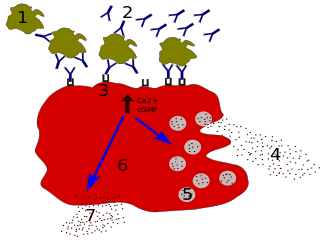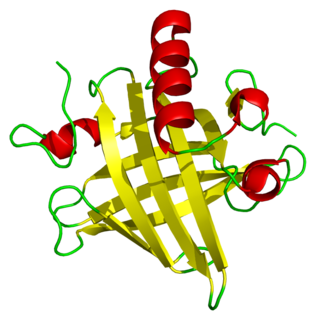
Allergies, also known as allergic diseases, are a number of conditions caused by hypersensitivity of the immune system to typically harmless substances in the environment. These diseases include hay fever, food allergies, atopic dermatitis, allergic asthma, and anaphylaxis. Symptoms may include red eyes, an itchy rash, sneezing, a runny nose, shortness of breath, or swelling. Food intolerances and food poisoning are separate conditions.

Allergic rhinitis, also known as hay fever, is a type of inflammation in the nose which occurs when the immune system overreacts to allergens in the air. Signs and symptoms include a runny or stuffy nose, sneezing, red, itchy, and watery eyes, and swelling around the eyes. The fluid from the nose is usually clear. Symptom onset is often within minutes following exposure and they can affect sleep, the ability to work, and the ability to concentrate at school. Those whose symptoms are due to pollen typically develop symptoms during specific times of the year. Many people with allergic rhinitis also have asthma, allergic conjunctivitis, or atopic dermatitis.
A radioallergosorbent test (RAST) is a blood test using radioimmunoassay test to detect specific IgE antibodies, to determine the substances a subject is allergic to. This is different from a skin allergy test, which determines allergy by the reaction of a person's skin to different substances.

Immunoglobulin E (IgE) is a type of antibody that has only been found in mammals. IgE is synthesised by plasma cells. Monomers of IgE consist of two heavy chains and two light chains, with the ε chain containing 4 Ig-like constant domains (Cε1-Cε4). IgE's main function is immunity to parasites such as helminths like Schistosoma mansoni, Trichinella spiralis, and Fasciola hepatica. IgE is utilized during immune defense against certain protozoan parasites such as Plasmodium falciparum.

Rhinitis, also known as coryza, is irritation and inflammation of the mucous membrane inside the nose. Common symptoms are a stuffy nose, runny nose, sneezing, and post-nasal drip.

A food allergy is an abnormal immune response to food. The symptoms of the allergic reaction may range from mild to severe. They may include itchiness, swelling of the tongue, vomiting, diarrhea, hives, trouble breathing, or low blood pressure. This typically occurs within minutes to several hours of exposure. When the symptoms are severe, it is known as anaphylaxis. A food intolerance and food poisoning are separate conditions, not due to an immune response.

Latex allergy is a medical term encompassing a range of allergic reactions to the proteins present in natural rubber latex. Latex allergy generally develops after repeated exposure to products containing natural rubber latex. When latex-containing medical devices or supplies come in contact with mucous membranes, the membranes may absorb latex proteins. The immune system of some susceptible individuals produces antibodies that react immunologically with these antigenic proteins. As many items contain or are made from natural rubber, including shoe soles, elastic bands, rubber gloves, condoms, baby-bottle nipples, and balloons, there are many possible routes of exposure that may trigger a reaction. People with latex allergies may also have or develop allergic reactions to some fruits, such as bananas.
Omalizumab, sold under the trade name Xolair, is a medication originally designed to reduce sensitivity to allergens. It has been used to try to control severe allergic asthma, which does not respond to high doses of corticosteroids and less widely for chronic spontaneous urticaria.
Allergen immunotherapy, also known as desensitization or hypo-sensitization, is a medical treatment for environmental allergies, such as insect bites, and asthma. Immunotherapy involves exposing people to larger and larger amounts of allergen in an attempt to change the immune system's response.

Atopy is a predisposition toward developing certain allergic hypersensitivity reactions.

The term hypoallergenic dog breed is commonly used to refer to a dog breed that is more compatible with allergic people than other breeds. However, prominent allergen researchers have claimed that there is no basis to the claims that certain breeds are hypoallergenic and, while allergen levels vary among individual dogs, the breed is not a significant factor.
Cross-reactivity, in a general sense, is the reactivity of an observed agent which initiates reactions outside the main reaction expected.
Cat allergy in humans is an allergic reaction to one or more allergens produced by cats. The most common of these allergens are the glycoprotein Fel d 1, secreted by the cat's sebaceous glands and Fel d 4, which is expressed in saliva. An allergic reaction is a histamine reaction that is usually characterized by coughing, wheezing, chest tightening, itching, nasal congestion, rash, watering eyes, sneezing, chapped lips, and similar symptoms. In some severe cases, reactions may progress rapidly to cause the victim's airway to become inflamed and close up, requiring emergency medical attention. Those with severe, life-threatening cat allergies face tremendous challenges due to lack of public awareness about anaphylactic cat allergies, and do not enjoy the same conscientiousness from the public as those with a food allergy might, due to widespread knowledge of allergies to allergens such as nuts or dairy.

Milk allergy is an adverse immune reaction to one or more proteins in cow's milk. When allergy symptoms occur, they can occur rapidly or have a gradual onset. The former may include anaphylaxis, a potentially life-threatening condition which requires treatment with epinephrine among other measures. The latter can take hours to days to appear, with symptoms including atopic dermatitis, inflammation of the esophagus, enteropathy involving the small intestine and proctocolitis involving the rectum and colon.

Egg allergy is an immune hypersensitivity to proteins found in chicken eggs, and possibly goose, duck, or turkey eggs. Symptoms can be either rapid or gradual in onset. The latter can take hours to days to appear. The former may include anaphylaxis, a potentially life-threatening condition which requires treatment with epinephrine. Other presentations may include atopic dermatitis or inflammation of the esophagus.

Wheat allergy is an allergy to wheat which typically presents itself as a food allergy, but can also be a contact allergy resulting from occupational exposure. Like all allergies, wheat allergy involves immunoglobulin E and mast cell response. Typically the allergy is limited to the seed storage proteins of wheat. Some reactions are restricted to wheat proteins, while others can react across many varieties of seeds and other plant tissues. Wheat allergy is rare. Prevalence in adults was found to be 0.21% in a 2012 study in Japan.

Ara h 1 is a seed storage protein from Arachis hypogaea (peanuts). It is a heat stable 7S vicilin-like globulin with a stable trimeric form that comprises 12-16% of the total protein in peanut extracts. Ara h 1 is known because sensitization to it was found in 95% of peanut-allergic patients from North America. In spite of this high percentage, peanut-allergic patients of European populations have fewer sensitizations to Ara h 1.
Alpha-gal allergy, also known as meat allergy or mammalian meat allergy (MMA), is a reaction to galactose-alpha-1,3-galactose (alpha-gal), whereby the body is overloaded with immunoglobulin E (IgE) antibodies on contact with the carbohydrate. The alpha-gal molecule is found in all mammals apart from Old World monkeys and the apes, which include humans. Anti-gal is a human natural antibody that interacts specifically with the mammalian carbohydrate structure gal alpha 1-3Gal beta 1-4GlcNAc-R, termed, the alpha-galactosyl epitope. Whereas alpha-gal is absent from humans, apes, and Old World monkeys, it is abundant in New World monkeys, prosimians, and nonprimate mammals.
Exercise-Induced Anaphylaxis (EIAn) is a rare condition in which anaphylaxis, a serious or life-threatening allergic response, is brought on by physical activity. Approximately 5-15% of all reported cases of anaphylaxis are thought to be exercise-induced.













